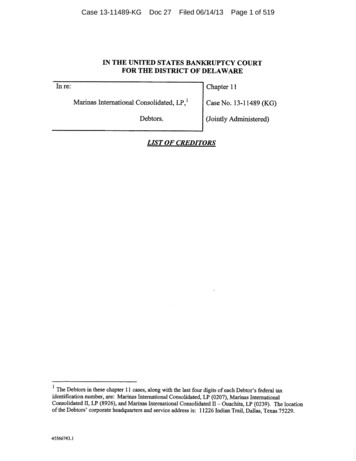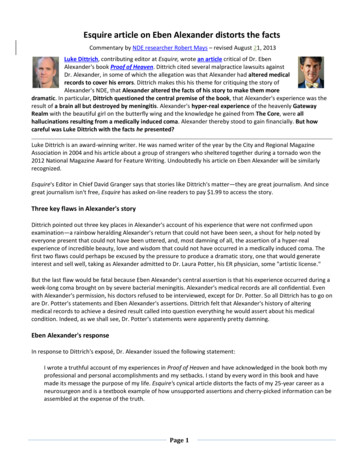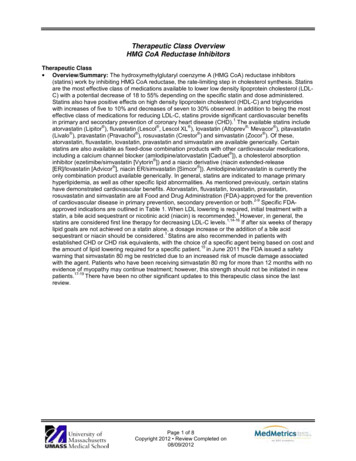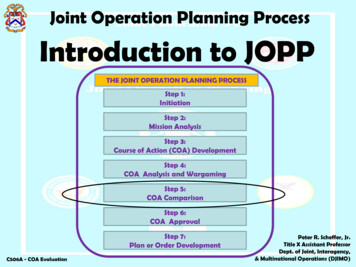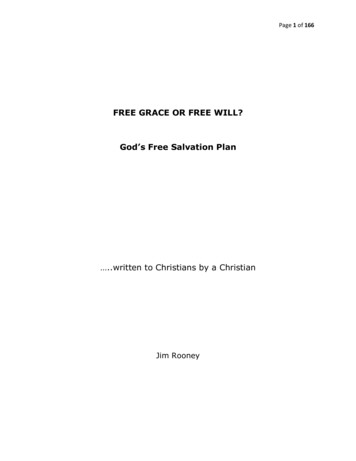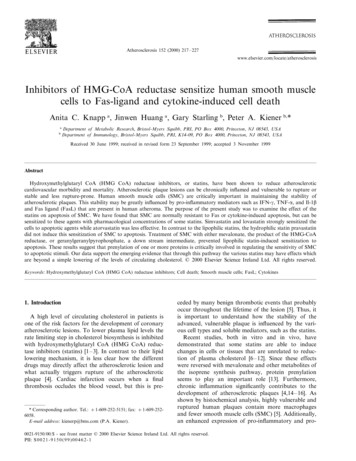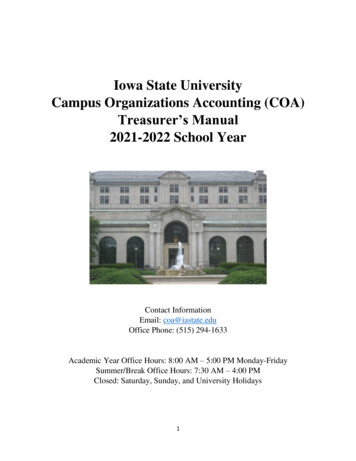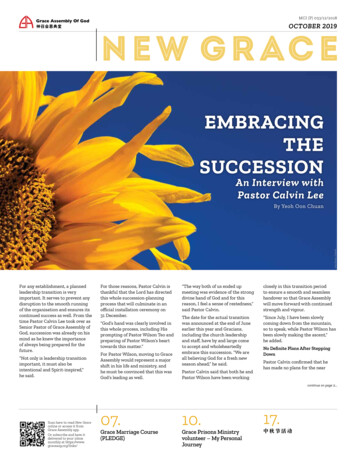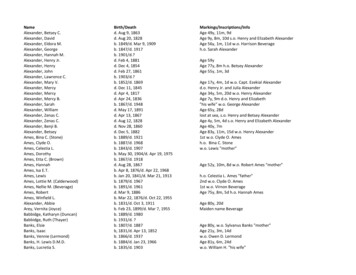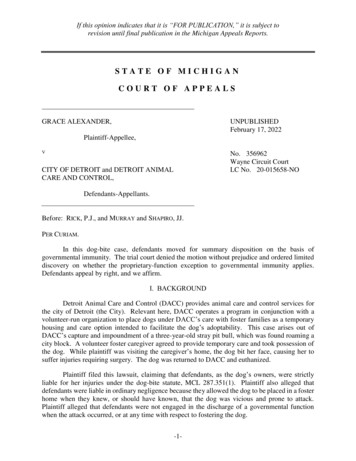
Transcription
If this opinion indicates that it is “FOR PUBLICATION,” it is subject torevision until final publication in the Michigan Appeals Reports.STATE OF MICHIGANCOURT OF APPEALSGRACE ALEXANDER,UNPUBLISHEDFebruary 17, 2022Plaintiff-Appellee,VNo. 356962Wayne Circuit CourtLC No. 20-015658-NOCITY OF DETROIT and DETROIT ANIMALCARE AND CONTROL,Defendants-Appellants.Before: RICK, P.J., and MURRAY and SHAPIRO, JJ.PER CURIAM.In this dog-bite case, defendants moved for summary disposition on the basis ofgovernmental immunity. The trial court denied the motion without prejudice and ordered limiteddiscovery on whether the proprietary-function exception to governmental immunity applies.Defendants appeal by right, and we affirm.I. BACKGROUNDDetroit Animal Care and Control (DACC) provides animal care and control services forthe city of Detroit (the City). Relevant here, DACC operates a program in conjunction with avolunteer-run organization to place dogs under DACC’s care with foster families as a temporaryhousing and care option intended to facilitate the dog’s adoptability. This case arises out ofDACC’s capture and impoundment of a three-year-old stray pit bull, which was found roaming acity block. A volunteer foster caregiver agreed to provide temporary care and took possession ofthe dog. While plaintiff was visiting the caregiver’s home, the dog bit her face, causing her tosuffer injuries requiring surgery. The dog was returned to DACC and euthanized.Plaintiff filed this lawsuit, claiming that defendants, as the dog’s owners, were strictlyliable for her injuries under the dog-bite statute, MCL 287.351(1). Plaintiff also alleged thatdefendants were liable in ordinary negligence because they allowed the dog to be placed in a fosterhome when they knew, or should have known, that the dog was vicious and prone to attack.Plaintiff alleged that defendants were not engaged in the discharge of a governmental functionwhen the attack occurred, or at any time with respect to fostering the dog.-1-
In lieu of filing an answer, defendants moved for summary disposition under MCR2.116(C)(7), arguing that as governmental agencies they were entitled to immunity under thegovernmental tort liability act (GTLA), MCL 691.1401 et seq. Defendants argued that DACC, byimpounding and placing the dog with a foster-care provider as an alternative to sheltering oreuthanizing it, was exercising a governmental function of caring for and controlling the City’sstray animals, as authorized by the City’s animal-control ordinance.In response, plaintiff argued that defendants were not exercising a governmental functionbecause they were not “in the course of capturing or otherwise handling the dog” when it bit her.Plaintiff alternatively argued that discovery was needed to determine whether the proprietaryfunction exception to governmental immunity, MCL 691.1413, applied on the grounds thatdefendants intended to sell the dog. Plaintiff also alternatively argued that the GTLA did not barher claim under the dog-bite statute because that statute had necessarily abrogated governmentalimmunity for damages resulting from an unprovoked bite. In reply, defendants argued thatplaintiff failed to plead the proprietary-function exception and did not offer any factual support insupport of that claim.The trial court denied defendants’ motion without prejudice and ordered that the “partieswill be allowed limited discovery for 60 days on the proprietary-function exception.” This appealfollowed.1II. DISCUSSIONWe review de novo a trial court’s decision regarding a motion for summary disposition. Eplee vLansing, 327 Mich App 635, 644; 935 NW2d 104 (2019). When considering a motion under MCR2.116(C)(7), we accept the factual pleadings as true unless evidence contradicts them. Dextrom vWexford Co, 287 Mich App 406, 428; 789 NW2d 211 (2010). We consider the affidavits,pleadings, depositions, and other documentary evidence and determine whether a genuine issue ofmaterial fact exists. Id. at 429. If there are no questions of fact, whether the claim is barred is amatter of law, but “if a question of fact exists as to the extent that factual development couldprovide a basis for recovery, dismissal is inappropriate.” Id. We also review de novo questionsof statutory interpretation. Glasker-Davis v Auvenshine, 333 Mich App 222, 229; 964 NW2d 809(2020).1In addition to contesting the denial of summary disposition on the basis of governmentalimmunity, defendants argue that DACC does not have the legal capacity to be sued. This distinctclaim lies outside the scope of this Court’s limited jurisdiction to hear defendants’ appeal by rightof the trial court’s denial of their motion for summary disposition under MCR 2.116(C)(7) on thebasis of governmental immunity. See Pierce v Lansing, 265 Mich App 174, 182; 694 NW2d 65(2005) (“[I]n an appeal by right from an order denying a defendant’s claim of governmentalimmunity, such as this one, this Court does not have the authority to consider issues beyond theportion of the trial court’s order denying the defendant’s claim of governmental immunity.”).Accordingly, we do not address that issue.-2-
A. GOVERNMENTAL FUNCTIONThe parties first dispute whether defendants were engaged in a governmental functionwhen operating the dog foster-care program such that they are generally entitled to tort immunity.See MCL 691.1407(1) (“Except as otherwise provided in this act, a governmental agency isimmune from tort liability if the governmental agency is engaged in the exercise or discharge of agovernmental function.”).The GTLA defines “governmental function” as “activity that is expressly or impliedlymandated or authorized by constitution, statute, local charter or ordinance, or other law.” MCL691.1401(b). This definition is interpreted broadly and “requires only that there besome constitutional, statutory or other legal basis for the activity in which the governmental agencywas engaged.” Genesee Co Drain Comm’r v Genesee Co, 309 Mich App 317, 327; 869 NW2d635 (2015) (quotation marks and citation omitted). To determine if an act constitutes agovernmental function, we consider the government’s general rather than specific conduct.Pardon v Finkel, 213 Mich App 643, 649; 540 NW2d 774 (1995). Governmental immunity doesnot provide a shield for ultra vires activity, which is “defined as activity not expressly or impliedlymandated or authorized by law.” Richardson v Jackson Co, 432 Mich 377, 381; 443 NW2d 105(1989) (emphasis removed).DACC’s authority regarding the care and control of the City’s animals is derived from theCity’s animal-control ordinance,2 which grants broad authority in that area. See 2019 Detroit CityCode, § 6-1-1 et seq.3 The ordinance specifically authorizes DACC to “impound any animal whichis stray, loose, running at large,” id., § 6-1-9(a), “to seize and impound any stray dog that is onpublic or private property . . . and to return, sell, transfer, or euthanize any such animal inaccordance with this chapter,” id., § 6-2-3(a), and to control the operation of, and maintain, theCity’s animal-control shelter “in the interest of the health and welfare of any animals captured orentrusted to its custody or care,” id., § 6-4-1, which “shall seize, capture, impound, and harbor allstray animals,” id., § 6-4-3. The ordinance also expressly permits DACC to “contract with anynon-profit corporation that is organized for the purpose of sheltering animals to assist in the care,impoundment, release, or adoption of stray animals not determined to be dangerous by the AnimalCare and Control Division.” Id., § 6-1-9(c). No provisions expressly authorize the placement ofunclaimed impounded animals with foster-care providers.DACC’s capture and impoundment of the subject pit bull clearly constituted a governmental function as expressly authorized under the animal-control ordinance. 2019 Detroit CityOrdinance, §§ 6-2-3(a) and 6-4-3. DACC was also acting within its express authority in makinga determination regarding the dog’s dangerousness, or lack thereof. See id., §§ 6-1-9(c) and 6-31. The activity in question, however, is DACC’s operation of a foster-care program. It isundisputed that the subject dog bit plaintiff while in the home, and under the care, of a volunteerfoster-care provider, pursuant to an agreement with DACC, while DACC retained rights and2The City has statutory authority to adopt an animal-control ordinance. MCL 287.290.3We refer to the version of the 2019 Detroit City Code in effect when the subject dog bite occurredon July 13, 2020.-3-
responsibilities with respect to the dog’s care, control, and disposition. Thus, at issue is whetherthe ordinance impliedly authorizes DACC to place impounded dogs with foster-care providers forcare and housing outside of the City’s shelter.As noted, the ordinance grants DACC broad authority to enforce its provisions, includingthe care, control, and disposition of the City’s animals, and to operate and maintain the City’sanimal shelter. See 2019 Detroit City Code, § 6-1-4(a). DACC is authorized to impound, id., § 61-2, and harbor, id., § 6-4-3, the City’s stray animals, but it is also permitted to “sell” or “transfer”unclaimed stray dogs, id., § 6-2-3(a). The governmental activity in “transferring” a stray dogencompasses the adoption of stray dogs by the public, or the conveyance of ownership of suchdogs to other shelters or rescue organizations for adoption. The ordinance explicitly permitsDACC to “contract with any non-profit corporation that is organized for the purpose of shelteringanimals to assist in the care, impoundment, release, or adoption of stray animals not determinedto be dangerous” by DACC. Id., § 6-1-9(c) (emphasis added). Thus, DACC’s fostering activityperformed in conjunction with a nonprofit organization in temporarily placing stray, impoundeddogs with foster-care providers to ready such dogs for adoption is closely related to and supportsits governmental activities in the adoption, transfer, and release of such dogs, as well as inmaintaining “the health and welfare of animals of any animals captured or entrusted to its custodyor care.” Detroit City Code, § 6-4-1. We therefore conclude that the fostering activity wasimpliedly authorized under the ordinance. Because defendants were engaged in a governmentalfunction, they are immune from tort liability under the GTLA unless the activity falls within oneof the enumerated statutory exceptions. Snead v John Carlo, Inc, 294 Mich App 343, 356; 813NW2d 294 (2011).B. DOG-BITE STATUTENext, the parties dispute whether governmental immunity bars plaintiff’s claim underMichigan’s dog-bite statute, which imposes strict liability on dog owners for unprovoked bites:If a dog bites a person, without provocation while the person is on publicproperty, or lawfully on private property, including the property of the owner of thedog, the owner of the dog shall be liable for any damages suffered by the personbitten, regardless of the former viciousness of the dog or the owner’s knowledge ofsuch viciousness. [MCL 287.351(1).]Plaintiff asserts that defendants are absolutely liable under that statute, whereas defendants arguethat they are immune under the GTLA from the liability imposed by the dog-bite statute.The dog-bite statute “has consistently been interpreted as creating an almost absoluteliability in the dog owner, except in instances of provocation.” Tate v Grand Rapids, 256 MichApp 656, 658; 671 NW2d 84 (2003) (quotation marks and citations omitted). However, this Courthas recognized that claims under the dog-bite statute are subject to governmental immunity:Plaintiff argues that his cause of action is not one of “tort liability” but rather“strict liability” and, thus, is not within the reach of the GTLA. . . . The GTLAprovides governmental agencies immunity from “tort liability.” At issue is whetherthe dog-bite statute is outside the reach of the “tort liability” provision of the GTLA.We conclude that it is not. [Id. at 659 (footnote omitted).]-4-
This Court elaborated as follows:The GTLA unambiguously grants immunity from all tort liability, i.e., civilwrongs for which legal responsibility is recognized, regardless of how the legalresponsibility is determined, except as otherwise provided in the GTLA. Consequently, plaintiff’s argument that his claim is exempt from the GTLA because it isnot one of tort liability is without merit. Accordingly, the trial court properlydismissed plaintiff’s strict liability claim on the ground that it was barred bygovernmental immunity. [Id. at 660-661.]Thus, under Tate, plaintiff’s claim under the dog-bite statute is subject to governmental immunity.Moreover, we disagree with plaintiff’s argument that the Legislature intended to abrogategovernmental immunity in connection with the dog-bite statute. “A central tenant of . . .governmental immunity is that the state may be held liable in a court of law only when the statehas expressly permitted a suit against it.” Odom v Wayne Co, 482 Mich 459, 477; 760 NW2d 217(2008). In enacting the GTLA, the Legislature did not include matters relating to animal care orcontrol among its listed exceptions. And, in enacting the dog-bite statute, the Legislature did notspecify that governmental agencies came under the strict liability imposed for injuries resultingfrom dog bites. Indeed, MCL 287.351 neither defines “owner of the dog” nor mentions the stateor its political subdivisions. See Ballard v Ypsilanti Twp, 457 Mich 564, 575-576; 577 NW2d 890(1998) (“There is no express waiver of governmental immunity from liability under the[Recreational Land Use Act], because the act does not define the persons to whom it applies toinclude either the state or its political subdivisions.”). If the Legislature meant to limitgovernmental immunity in such circumstances it could have expressly done so, but it did not.For these reasons, we reject plaintiff’s argument that governmental immunity under theGTLA does not apply to a claim brought under the dog-bite statute.C. PROPRIETARY-FUNCTION EXCEPTIONFinally, defendants argue that the trial court should have granted summary dispositionbecause plaintiff failed to plead the proprietary-function exception to governmental immunity inher complaint. We disagree.The exceptions to governmental immunity are narrowly construed. Nawrocki v MacombCo Rd Comm, 463 Mich 143, 158; 615 NW2d 702 (2000). The proprietary-function exception,MCL 691.1413, provides as follows:The immunity of the governmental agency shall not apply to actions torecover for bodily injury or property damage arising out of the performance of aproprietary function as defined in this section. Proprietary function shall mean anyactivity which is conducted primarily for the purpose of producing a pecuniaryprofit for the governmental agency, excluding, however, any activity normallysupported by taxes or fees.In this case, plaintiff did not plead the proprietary-function exception in her complaint, butrather maintained generally that defendants were not engaged in a governmental function with-5-
respect to their fostering activity. Plaintiff then invoked the proprietary-function exception inresponse to defendants’ motion for summary disposition. At that early stage of the litigation,plaintiff still had the right to amend her complaint, as a matter of course, under MCR 2.118(A)(1),which permits a party to “amend a pleading once as a matter of course within 14 days after beingserved with a responsive pleading by an adverse party.” Because defendants’ motion for summarydisposition did not constitute a responsive pleading, see MCR 2.110(A); Huntington Woods v AjaxPaving Indus, Inc, 179 Mich App 600, 601; 446 NW2d 331 (1989), plaintiff’s right to amend hercomplaint has not expired.Defendants further argue that they are entitled to summary disposition because plaintiff’sargument that they intended to sell the dog for a pecuniary benefit was “unsubstantiated” and“demonstrably false.” In effect, defendants are challenging the trial court’s decision to defer rulingon the applicability of the proprietary-function exception until pertinent discovery has beencompleted. “Generally, a motion for summary disposition is premature if granted before discoveryon a disputed issue is complete,” but “summary disposition may nevertheless be appropriate iffurther discovery does not stand a reasonable chance of uncovering factual support for theopposing party’s position.” Peterson Novelties, Inc v City of Berkley, 259 Mich App 1, 24-25, 672NW2d 351 (2003).DACC’s director submitted an affidavit attesting that DACC does not currently charge afee for adopted dogs and that its activities are supported by taxes, not profits. Although theseassertions tend to refute plaintiff’s claim that the proprietary-function exception to governmentalimmunity applies, plaintiff is not in position to challenge these statements until she obtainsdiscovery. Further, the facts are largely undeveloped regarding whether DACC’s nonprofit partnerin operating the foster program charges for adoptions, or how that nonprofit’s fostering activitiesare supported by donations, grants, or otherwise, and whether DACC receives any pecuniarybenefit from the partnership. Because further evidentiary development of such issues could shedlight on whether plaintiff can maintain her claim that the proprietary-function exception applies topreclude governmental immunity, we conclude that the trial court did not abuse its discretion inallowing discovery in that regard.In sum, we find no error in the trial court’s denial of defendants’ motion for summarydisposition predicated on governmental immunity pending discovery in connection with theproprietary-function exception. Affirmed./s/ Michelle M. Rick/s/ Christopher M. Murray/s/ Douglas B. Shapiro-6-
The dog-bite statute "has consistently been interpreted as creating an almost absolute liability in the dog owner, except in instances of provocation." Tate v Grand Rapids, 256 Mich App 656, 658; 671 NW2d 84 (2003) (quotation marks and citations omitted). However, this Court has recognized that claims under the dog-bite statute are subject .


